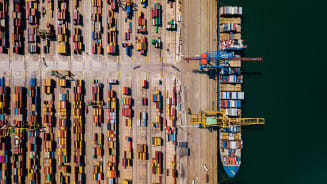More Like This
-
Article
The Future of Risk: Energy
-
Article
Rethinking Women in Construction

The global consumption of energy, and its impact on the planet, is being scrutinized. In response to the climate emergency, governments, institutions and businesses across the globe join the United Nations Paris Agreement coalition and take action to limit global temperature within 1.5° of pre-industrial levels and reach net zero carbon emissions by 2050.
As organisations look for new ways to power their business through renewables and lower carbon emissions, they must also continue their production in order to provide for an ever-growing global population. However, a combination of the current inflationary environment, geopolitical challenges and supply chain disruptions has resulted in sharp increases in energy prices as well as continued volatility in pricing.
Exposed to relentless energy volatility, environmental pressures and the need to continue production to generate revenue, organizations in industrial materials and manufacturing sectors face a dilemma: absorb inflated costs or down tools and turn off the lights. Either way, organizations are paying the price for energy.
To navigate energy volatility and associated business risks, leaders must not only identify new ways to power their business, but rethink their approach to protect it. This article explores the factors impacting energy for the heavy industry, and why organizations in the construction, industrial materials and manufacturing sectors can benefit from rethinking their approach to risk.
Heavy industry is severely impacted by volatility in the energy industry, where geopolitics and environmental threats are contributing to rising costs. As businesses ramp up production rates post-pandemic, the demand for energy has led market prices to rise. The steady rise in global energy prices has also increased since early 2022, due to supply constraints caused by Russia’s invasion of Ukraine.
European energy market pressures have severely impacted the bottom line for industrial materials and manufacturing organizations who are forced to increase their energy spend. In turn, this causes a knock-on effect to the construction industry through increased price volatility of inputs and construction materials. Between 23rd February 2022, the day before the start of the Russia-Ukraine conflict, and 31st July 2022, European wholesale gas prices increased by 115% and electricity increased by 237%.1
Energy is Powering Political Agendas
Using energy supply as a geopolitical tool, Russia’s dominance in the European oil and gas market means natural gas
supplies are predicted to remain constricted in 2023.2
Tensions Restrict Energy Production and Supply
As geopolitical tensions between countries across Asia and Europe continue, some countries look to stockpile their
energy, increasing the insecurity of energy supplies. As a result of OPEC’s cuts to oil production, the rising cost
of oil3 has disrupted production, distribution and supply across the heavy industries.
Invasion Brings Inflation
The Russian invasion of Ukraine has continued to cause global supply chain disruptions, inflating the prices of
essential commodities such as fuel and food across the globe.4
The inflation of fossil fuel prices and insecurity of supply impacts the day-to-day operations of heavy industries across the globe, triggered by the events and responses across the EMEA region. Whether paying upfront to secure and stockpile supply, halting their production and facing financial losses due to less output, or investing in a renewable energy infrastructure, manufacturing and industrial materials organizations are facing stark financial consequences when it comes to energy volatility.
In addition to the headwinds of energy volatility, heavy industry also faces the strain of supply chain insecurity. A lack of supply of goods and components hinders the ability to complete projects on time and interrupts business cash flow. Interruptions to material supply chains are caused by a cocktail of geopolitical, environmental and operational events. Although regional stoppages in production can impact the global economy, manufacturing hubs are faced with little option but to halt their output.
Reliance on materials from specific areas and manufacturers puts pressure on supply chains. For example, a factory fire in Japan halted semiconductor production for a month. This resulted in a global chip shortage disabling the automotive industry’s ability to source crucial supplies amidst the already mounting pressures of the pandemic, severe weather and geopolitical tensions.5
Companies operating within the construction and infrastructure ecosystem are suffering from increased costs to manufacture and production inputs. In addition, they are also facing the impact of increased energy costs and supply chain constraints on their own operations.
These pressures are having a direct effect on construction projects. Due to increased costs, budgets are coming in much higher than initially estimated during the contract bid phase. Additionally, projects already in execution are suffering as the cost to finish projects are suddenly rising. In many cases, projects are having to pause while parties find ways to finance the new cost, ultimately causing delays in the overall delivery of the project.
Supply chain constraints and bottlenecks continue to add additional challenges to the delivery of construction and infrastructure projects. The flow of construction materials is under threat from trading laws across the globe, where the supply of goods is impacted by geopolitical events. As project-critical materials are locked away in UK and European warehouses due to Brexit’s bureaucratic rules, trading tariffs such as Canadian timber restrictions contribute to material price fluctuations in the construction sector.11 This further exacerbates challenges with increased costs and delivery times for large construction projects, at a time of pressure to deliver more infrastructure assets.
The construction, industrial materials and manufacturing landscape requires organizations to look towards new solutions relative to the increased volatility it faces. While the challenges are clearly many, businesses who identify, mitigate and manage these factors contributing to this volatility will remain competitive in increasingly turbulent times.
Despite the cascade of disruptions threatening the heavy industry, organizations can develop strategies that are capable of withstanding current energy volatility. But it requires the adoption of alternative solutions with a holistic approach to risk. By reassessing risk solutions and strategy throughout the entire project lifecycle and supply chain, heavy industry organizations can ensure their business is covered for new and emerging risks. The reassessment of risk will also enable them to be more attractive to investors and have a positive impact on sustainability commitments.
Business interruptions and delays are escalating. Identifying bottlenecks helps organizations to better understand and assess their exposures. To increase resilience in the face of material shortages, leaders must solve supply chain challenges for the future, not just for today. Assessing the resiliency of contingency planning and identifying supply chain and potential disruptions helps businesses see where they may need alternative funding around critical component pieces.
"Traditional insurance mechanisms are increasingly obsolete relative to the underlying exposures that are driving volatility. We're seeing movement to more customized alternative funding and parametric solutions that are capable of managing volatility and maximizing performance.”
– Sal Perrucci, EVP and Managing Director, Enterprise Client Leader, Global Enterprise Client Group at Aon
Parametric solutions provide an alternative insurance risk financing arrangement that covers a predefined amount when a predetermined condition is met. Once an event happens, this sets off a parametric trigger such as a natural disaster or financial market change, leading to the payment of a pre-agreed amount to the policy holder, rather than a traditional indemnity-based payment.
Parametric solutions provide responsive programs that work for businesses that face both traditional risk and non-traditional emerging risks, such as supply chain disruptions, that require innovation risk financing approaches. Parametric solutions are particularly useful to combat non-property damage business interruptions events. Using alternative risk financing arrangements requires organizations to have people adept at risk preparedness by applying pre-emptive risk mitigation protocols across their enterprise risk profile.
"Aon can play an important role in helping clients to identify a “sweet spot” between risk retained and risk transferred to insurance markets to optimize costs. With alternative structures such as captive or protected cells, clients can build a retention vehicle or self-insure uninsurable risks. These can also serve as valuable data capture vehicles to help organizations better understand their total cost of risk and identify claims trends among other things.”
– Donais Deetz, Director, EMEA Construction & Infrastructure at Aon
Heavy industry organizations, especially those that are large and established, are looking towards better alternative funding. Whether they're using a captive insurance company or other types of alternative funding mechanisms to explore non-traditional risks, solutions are being developed by working with the reinsurance market to get the support they need.
Governments and project developers involved in very complex projects such as civil infrastructure developments often push risk down the supply chain, causing those at the lower end of the chain to face more risk than they can comfortably manage with the tools they have in place. In Design Build and EPC contracts, owners continually contractually allocate more risk downstream. This can result in risk discrepancy, where the party responsible for the risk may not be the best equipped to handle it, which can lead to improper management of risks and result in higher losses.
Organizations can combat this risk through better contractual negotiation or by increasing the project balance toward newer contractual models such as Alliance Contracting or Integrated Project Delivery (IPD).
Article
The Future of Risk: Energy
Article
Rethinking Women in Construction
Given the high inflationary environment firms are currently operating in, the valuations for physical property as well as expected incomes are also reflecting the rising pace of inflation.
Whether it’s an operating manufacturing plant or highway or a subway line under construction, organizations need to factor the impact of inflation into their valuations of insured property or expected income revenue streams. Accurate valuation of property and expected revenues, be it business interruption or delay in start-up insurance, will avoid underinsurance and subsequent financial loss. Ensuring that actual property values have been adjusted for inflation will avoid under-valuing and remove the risk of the party not receiving a full pay out in the event of an insurance claim.
To ensure their business is protected, organizations must assess and readjust their values with cost-effective methodologies. Pinpointing gaps in insurance programs, gaining efficiencies in insurance purchases and negotiating more effectively with underwriters enables organizations to not only gain better value, but to make informed decisions about the deployment of risk management resources. Leaders should look to consistently reassess values in these key areas:
As organizations identify ways to build resilience into their supply chains and reduce their dependence on Russia and East Europe for raw materials, leaders can look to regional, localised sourcing strategies. But to further mitigate supply chain risk, leaders should ask the following questions.
Newer models, like alliance contracting or Integrated Project Delivery (IPD) look towards rethinking the risk allocation, getting to a shared outcome that reduces the potential of disagreement and financial loss.
Utilizing collaborative practices and procurement models helps to navigate and improve:
When it comes to devising and implementing risk strategies amid rising energy costs, heavy industry clients can benefit from a consultative partner who can anticipate their specific needs. Working with a risk partner across regions enables organizations to assess opportunities and challenges, especially those in production and supply chain, viewing a full picture of risk across their business.
Organizations must aim to reduce risk exposures by taking a holistic approach to risk, increasing their resilience in the face of the volatile energy landscape. Applying the same principles to risk as organizations apply to commodities – where issues are monetized – will enable businesses to have a better control of their capital.
To mitigate mounting pressures and deliver business growth, organizations should work with experienced partners who can help address alternative solutions for traditional and emerging risks – ensuring management across project lifecycles, geographies and supply chains.
1 The impact of the war in Ukraine on energy prices: Consequences for
firms’ financial performance, Centre for Economic Policy Research, October
2022
2 Energy
crisis prompts ESG rethink on oil and gas, FT, July
2022
3 OPEC defies Joe Biden with a big output cut, The Economist,
2022
4 How the Russia-Ukraine conflict is impacting supply chains,
Consultancy Europe, July 2022
5 Verdict, 2021
6 ING, 2022
7 FT,
2022
8 MAKE, 2022
9 CityA.M., 2022
10 Manufacturing, 2022
11 Construction industry hammered by material shortages, Raconteur,
August 2022
General Disclaimer
The information contained herein and the statements expressed are of a general nature and are not intended to address the circumstances of any particular individual or entity. Although we endeavor to provide accurate and timely information and use sources we consider reliable, there can be no guarantee that such information is accurate as of the date it is received or that it will continue to be accurate in the future. No one should act on such information without appropriate professional advice after a thorough examination of the particular situation.
Terms of Use
The contents herein may not be reproduced, reused, reprinted or redistributed without the expressed written consent of Aon, unless otherwise authorized by Aon. To use information contained herein, please write to our team.
Our Better Being podcast series, hosted by Aon Chief Wellbeing Officer Rachel Fellowes, explores wellbeing strategies and resilience. This season we cover human sustainability, kindness in the workplace, how to measure wellbeing, managing grief and more.
Stay in the loop on today's most pressing cyber security matters.
Our Cyber Resilience collection gives you access to Aon’s latest insights on the evolving landscape of cyber threats and risk mitigation measures. Reach out to our experts to discuss how to make the right decisions to strengthen your organization’s cyber resilience.
Our Employee Wellbeing collection gives you access to the latest insights from Aon's human capital team. You can also reach out to the team at any time for assistance with your employee wellbeing needs.
Explore Aon's latest environmental social and governance (ESG) insights.
Our Global Insurance Market Insights highlight insurance market trends across pricing, capacity, underwriting, limits, deductibles and coverages.
How do the top risks on business leaders’ minds differ by region and how can these risks be mitigated? Explore the regional results to learn more.
Our Human Capital Analytics collection gives you access to the latest insights from Aon's human capital team. Contact us to learn how Aon’s analytics capabilities helps organizations make better workforce decisions.
Explore our hand-picked insights for human resources professionals.
Our Workforce Collection provides access to the latest insights from Aon’s Human Capital team on topics ranging from health and benefits, retirement and talent practices. You can reach out to our team at any time to learn how we can help address emerging workforce challenges.
Our Mergers and Acquisitions (M&A) collection gives you access to the latest insights from Aon's thought leaders to help dealmakers make better decisions. Explore our latest insights and reach out to the team at any time for assistance with transaction challenges and opportunities.
How do businesses navigate their way through new forms of volatility and make decisions that protect and grow their organizations?
Our Parametric Insurance Collection provides ways your organization can benefit from this simple, straightforward and fast-paying risk transfer solution. Reach out to learn how we can help you make better decisions to manage your catastrophe exposures and near-term volatility.
Our Property Risk Management collection gives you access to the latest insights from Aon's thought leaders to help organizations make better decisions. Explore our latest insights to learn how your organization can benefit from property risk management.
Our Technology Collection provides access to the latest insights from Aon's thought leaders on navigating the evolving risks and opportunities of technology. Reach out to the team to learn how we can help you use technology to make better decisions for the future.
Trade, technology, weather and workforce stability are the central forces in today’s risk landscape.
Our Trade Collection gives you access to the latest insights from Aon's thought leaders on navigating the evolving risks and opportunities for international business. Reach out to our team to understand how to make better decisions around macro trends and why they matter to businesses.
With a changing climate, organizations in all sectors will need to protect their people and physical assets, reduce their carbon footprint, and invest in new solutions to thrive. Our Weather Collection provides you with critical insights to be prepared.
Our Workforce Resilience collection gives you access to the latest insights from Aon's Human Capital team. You can reach out to the team at any time for questions about how we can assess gaps and help build a more resilience workforce.

Article 7 mins
From global supply chain risks to climate insecurity, organizations face challenges and complexities on a scale rarely seen before.

Article 9 mins
Risk Capital CEO Andy Marcell and Human Capital CEO Lambros Lambrou discuss how innovations in Risk Capital and Human Capital can help organizations boost resilience and navigate volatility.

Report 28 mins
Global business leaders highlight risks linked to trade as some of their top concerns — both physical and financial. While the topic is complex and broad, there are opportunities that business leaders can pursue to stay ahead of emerging trade dynamics.